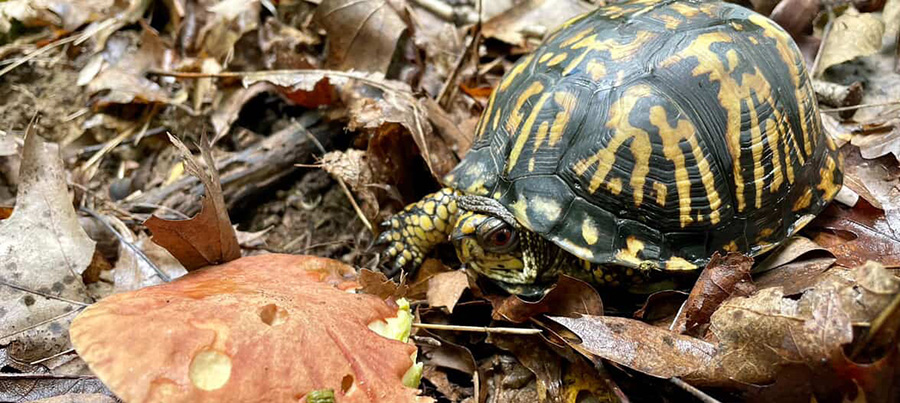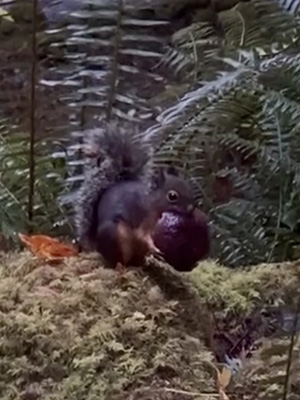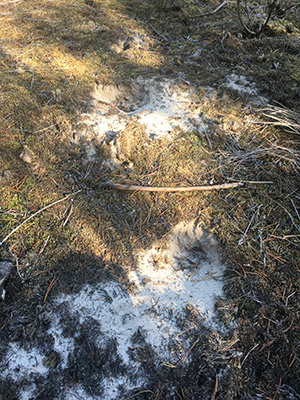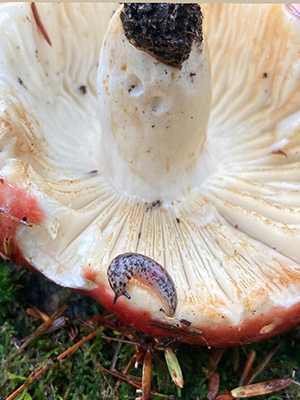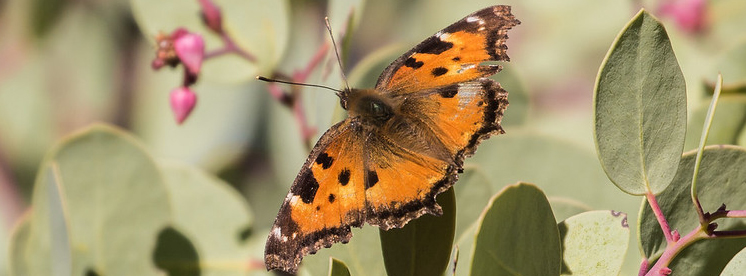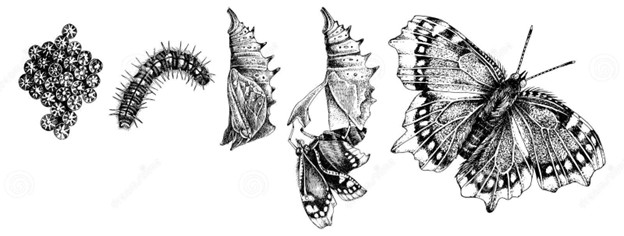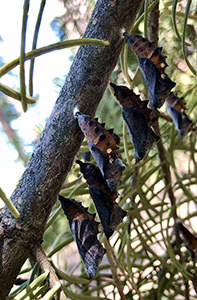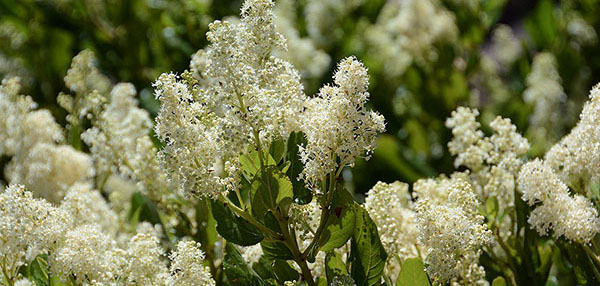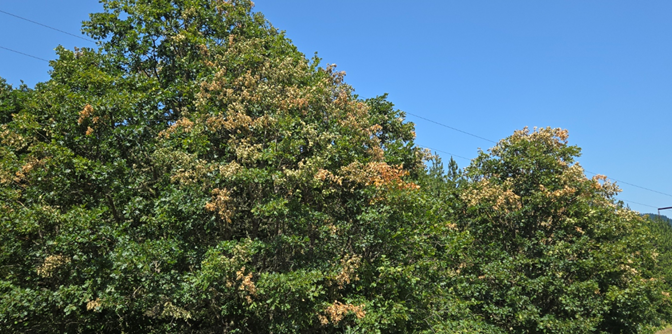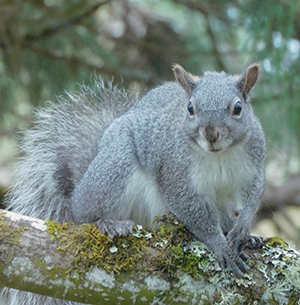By Lorelle Sherman, OSU Extension Forester

Oregon’s forests can look quiet in winter. Leaves are gone, wildflowers have faded, and many animals are harder to spot or have left on a migration to a warmer climate. This is because winter is a demanding season for wildlife. Food is scarcer, temperatures are lower, and shelter becomes essential. Life in forests does not stop when growth slows, though. It simply shifts, unfolding quietly in cavities, under bark, and within rotting wood.
Wildlife interact with dead wood at micro and macro scales, both in time and space. Microscopic fungal mycelium infiltrate stressed and dying trees, softening the wood just enough to become a nest site for the impressively large Pileated Woodpecker. Tiny insect larvae, or grubs, hibernate deep within rotting logs only to become a snack for the forest’s connoisseur of dead wood, black bears. These processes sometimes play out in days and sometimes in years.
So what is dead wood and why do we need it?
Dead wood describes both snags (standing dead trees) and downed wood (fallen logs and branches). Research from Oregon and across the Pacific Northwest shows that dead wood forms a complex, long-lasting ecological network that unfolds over decades or even centuries, depending on tree species, size, and environmental conditions. Dead wood is not static, but is a living, evolving habitat. Once a tree dies, decomposition is driven by fungi, insects, bacteria, and other organisms. Early stages of decomposition are dominated by insects and fungi that specialize in fresh wood, while later stages support mosses, plants, and microbes that contribute directly to soil formation.
Dead wood is sometimes seen as a nuisance – a wasted resource, tripping hazard, or even a fire hazard. Fortunately, the dead wood most important for wildlife is large, and large wood typically poses less fire risk than finer fuels. While dead wood can influence how fire moves through the landscape, it also plays a key role in shaping wildlife habitat.
Why do wildlife need dead wood?
Historically, undisturbed westside Oregon forests held ~10–18 snags and 50–140 down logs per acre (USDA DecAID). An abundance of deadwood in the environment led to numerous associations with wildlife. Over 40% of wildlife species in the Pacific Northwest forests interact with deadwood in some way. Mark Harmon, forest ecologist at Oregon State University, found that a single snag can have over 12,000 beetle galleries and hundreds of species of other associated organisms, including fungi, mites, nematodes, protozoa, and bacteria. Estimates say between 30-40 species of birds in the Pacific northwest depend on snags for nesting and feeding. Small rodents, like northern flying squirrels, and bats are also known to nest in cavities with bats sometimes also roosting under slabs of loose bark.
Pacific martens, fishers, black bears, and raccoons, too, use cavities (a hollow area or a hole in a natural structure). Cavities excavated by woodpeckers are too small for these creatures, so they rely on large cavities formed by decay or fire. These cavities are becoming increasingly more uncommon because old, large trees are now uncommon.
Why do wildlife need dead wood in the winter?
Reptiles and amphibians are ectothermic, meaning they rely on external sources to regulate their body temperature. So, utilizing the insulation of a hollow log, root hollow, rotting log, or slab of dead bark is essential to survival year-round, but especially during the winter months. During cold spells, snakes and lizards will slow their breathing and metabolic rates down (also known as brumation) during the dark days only leaving their insulated safe space on sunny days to bask on top of rocks or downed logs. Salamanders and frogs also brumate, but they don’t often bask as their permeable skin makes them highly susceptible to dehydration. Two salamanders that particularly depend on large downed wood are clouded salamanders and western red-backed salamanders.

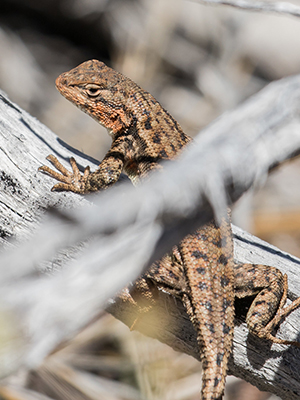
Small-bodied wildlife that generate their own internal heat (endothermic) still rely on dead wood for insulation. Mice, shrews, chipmunks, and squirrels will all find cavities or burrow under dead wood to get through the coldest temperatures. There are differences in dependence on dead wood by species, though. Small mammals that eat insects benefit even more from large downed wood as rotting logs can serve as a buffet for food in addition to protective habitat. Insect-eating species like the Pacific jumping and shrew-mole show a strong preference for sites with an abundance of large downed wood when compared with other small mammals (Maguire 2002). On the other hand, red tree voles don’t appear to associate with dead wood because they are canopy-dwellers and rarely come to the ground.
In the Pacific Northwest, most birds start nesting in the spring as warmer temperatures hint at the summer to come. Raptors (not the Jurassic Park kind… the owls, eagles and hawks kind) start courting their mate and selecting nest sites in the dead of winter. Great horned owls will even lay their eggs from January through March. Great horned owls will utilize broken or dead tops of large trees as well as large snag cavities. In fact, many of our owl species nest in snag cavities and will also utilize wooden boxes made by humans to replicate natural cavities.
How can I increase beneficial deadwood for wildlife on my property?
Incorporating dead wood into managed forests does not mean you have to sacrifice safety or productivity. Instead, it can involve thoughtful retention of a diversity of dead wood types—different sizes, tree species, and stages of decay. This structural diversity supports a wider range of species and ecological functions.
Landowners and managers can support wildlife and forest health by:
- Retaining snags where safe and feasible… the larger in diameter and height, the better!
- Where snags are not safe or feasible, like near your home or other structures, installing wooden nesting boxes to mimic cavities (different species require different sizes)
- Leaving large downed logs after harvest
- Creating habitat piles from logging slash
In winter especially, snags and fallen logs remind us that dead wood and decay is not a sign of neglect, but a fundamental part of how forests function. The next time you walk through a winter forest, pause at a standing snag or a large downed log and take a look around. What wildlife tracks do you see in the snow?
Read more about forest ecologist Mark Harmon and his work with dead wood.

